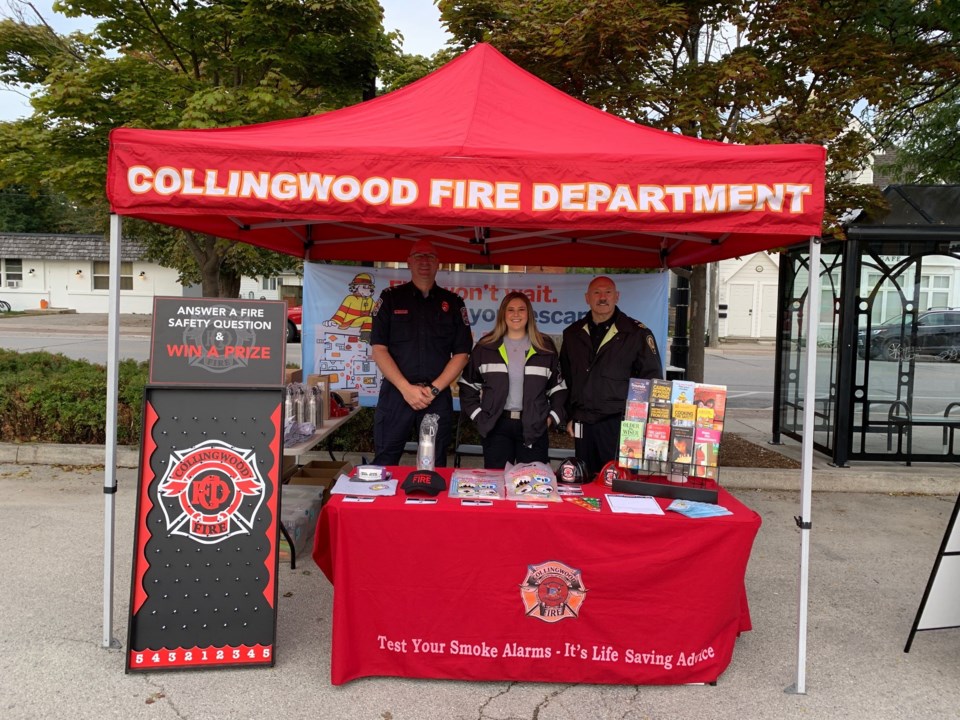Though fire prevention is ongoing work for Collingwood Fire Department's Carl Prochilo, the fire prevention officer, there's one week a year that's especially important.
Fire Prevention Week starts on Sunday, Oct. 9 and runs through Oct. 15. This year’s theme is “Fire Won’t Wait. Plan Your Escape,” reinforcing the critical importance of developing a home escape plan with all members of the household and practising it regularly.
This October also marks the 100th anniversary of Fire Prevention Week, the nation’s longest-running public health observance on record.
One hundred years ago, solid furnishings and construction burned slower than the plastics, synthetics, and lightweight products in homes today. Occupants had time to escape if they were alerted to smoke or fire. Today’s homes burn faster than ever, with as little as two minutes to get out of a burning building before the circumstances become untenable. A closed door may slow the spread of smoke, heat, and fire. It’s critical that everyone in the home – including guests – knows and practises a home fire escape plan at least twice a year.
This centennial Fire Prevention Week, consider all types of homes, and all types of occupants: single-family, townhomes, apartments, hotels and motels, campers and RVs; adults, older adults, children, people with mobility challenges and those who are deaf or hard of hearing. Pets too can also be included in your home escape plan.
- Different homes have different plans. Know what to do and where to go if there is a fire.
- Have a home fire escape plan for everyone in your home. Some people may need help waking up or getting outside, including those with sensory or physical disabilities. Plan accordingly.
- Smoke alarms should be installed inside every sleeping room, outside each separate sleeping area, and on every level of your home. Smoke alarms should be interconnected so that when one sounds, they all sound.
- Protect your loved ones. Plan your home fire escape.
- Have an outside meeting place at a safe distance from your home where everyone should meet. Call 911 or the fire department from outside your home.
- Have a clear path to your exits.
- Knowing two ways out of every room is an important piece of your home fire escape plan.
- Have an outside meeting place at a safe distance from your home where everyone should meet.
- Practise your home fire drill at least twice a year with everyone in the household, including guests. Practise at least once during the day and at night.
Home fire escape planning and practice
It is important for everyone to plan and practise a home fire escape. Everyone needs to be prepared in advance, so that they know what to do when the smoke alarm sounds. Given that every home is different, every home fire escape plan will also be different.
Have a plan for everyone in the home. Children, older adults, and people with disabilities may need assistance to wake up and get out. Make sure that someone will help them!
Smoke alarms
Smoke alarms sense smoke well before you can, alerting you to danger. Smoke alarms need to be in every bedroom, outside of the sleeping areas (like a hallway), and on each level (including the basement) of your home. Do not put smoke alarms in your kitchen or bathrooms.
Choose an alarm that is listed with a testing laboratory, meaning it has met certain standards for protection.
For the best protection, use combination smoke and carbon monoxide alarms that are interconnected throughout the home. These can be installed by a qualified electrician, so that when one sounds, they all sound. This ensures you can hear the alarm no matter where in your home the alarm originates. Educate everyone about simple but important actions they can take to keep themselves and those around them safe from home fires.
There are smoke alarms and alert devices made to alert people who are deaf or hard of hearing. These devices include strobe lights that flash to alert people when the smoke alarm sounds. Pillow or bed shakers designed to work with your smoke alarm also can be purchased and installed. These work by shaking the pillow or bed when the smoke alarm sounds. These products can be found online and in stores that sell smoke and CO alarms.
Make sure to choose smoke alarms and accessories that are listed by a qualified testing laboratory for people who are deaf or hard of hearing. It's also good practice to sleep with your mobile phone and your hearing aids or implants close to your bed.
Make sure your smoke and CO alarms meet the needs of all your family members, including those with sensory or physical disabilities.
Some tips:
- Install a bedside alert device that responds to the sound of the smoke and CO alarms. The use of a low-frequency alarm can also wake a sleeping person with mild to severe hearing loss.
- Sleep with your mobility device, glasses, and phone close to your bed.
- Keep hallways lit with night lights and free from clutter to ensure everyone can get out safely.
- Make sure everyone in your home understands and reacts to the signal (light, vibration, or sound) used in their situation.
- All smoke alarms should be tested at least monthly. Replace smoke alarms and equipment for people who are deaf or hard or hearing according to manufacturer’s recommendations.
Talk to everyone in your household and make a plan. For more information, contact the Collingwood Fire Dept. Fire Prevention Division at 705-445-3920.
